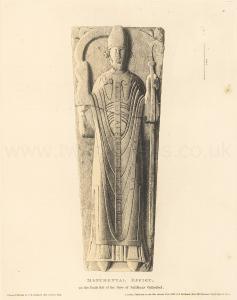Effigy of Jocelyn de Bailul Bishop of Salisbury
Effigy of Jocelyn de Bailul Bishop of Salisbury is in Monumental Effigies of Great Britain.
This, like the effigy of Jocelyn's predecessor in the See of Salisbury, is carved in low relief on a coffin lid. Jocelyn de Bailul was of a noble Norman family, and much in favour with King Henry the Second, whose views he espoused when the King sought to limit the extravagant privileges of the clergy by the constitutions of Clarendon. This drew upon Jocelyn the resentment of Becket, subjected him to ecclesiastical censures, and as much persecution as could by those means he directed against him. After the murder of Becket, nothing short of Jocelyn's entire submission could make his peace with the Pope. He retired into a Cistertian monastery, where he died on the 11th September 1184. He left a natural son, Richard Fitz-Jocelyn, Archdeacon of Sarum, Bishop of Bath and Wells, and afterwards elected to the See of Canterbury, but who died before his election was confirmed. The effigy of this Bishop represents him standing under an arch, the pastoral staff in the left hand, the right elevated in the act of giving the benediction. Mr. Gough, who conceived this to be the tomb of Bishop Roger, in 1770 procured it to be raised above the level of the floor of the nave, and was thus enabled to read the inscription which runs round the perpendicular sides of the edge of the stone. This commences at the head of the figure, and is as follows:
FLENT HODIE SALESBERIE, QVIA DECIDIT ENSIS
JVSTITIE, PATER ECCLESIE SALISBIRIENSIS,
DVM VIGVIT MISEROS ALV1T, FASTVSQVE FOTENTVM
NON TIMVIT, SED CLAVA FVIT TERRORQVE NOCENTVM,
DE DUCIBVS, DE NOBIEIBVS PRIMORDIA DVXIT
PRINCIPIBVS, PROPEQUE TIBI QVI GEMMA RELVXIT.
The line on the chasuble, "......AFFER OPEM, DEVENIES IN IDEM," is an admonition to the living to pray for the soul of the defunct, remembering their own mortality. Round the border of the same vestment was another inscription, which is now illegible.
Mr. Gough has endeavoured, by assigning particular allusions to the different lines of this inscription, to prove that this was the effigy of Bishop Roger; but these allusions, except in one point, are in a style of general compliment, which would apply equally well to Jocelyn as to Roger, while two circumstances lead confidently to the conclusion that this is the monument of Jocelyn: first, the only precise fact recorded in the epitaph, "deducibus, denobihbus primordia duxit principibus," seems at direct variance with the received history of Bishop Roger, while it perfectly accords with that of Bishop Jocelyn. The house of Bailul, or Bailleul, anglicised Baliol, whence he was descended, was one of the noblest in Normandy, distinguished for their voyages to the Holy Land, and their share in the conquest of England. The second circumstance is equally strong for its appropriation to Jocelyn. In searching the Chapter Records of Salisbury, several deeds were found bearing the seal of Bishop Jocelyn, the figure on which exactly resembled that on the monument which we are describing, and totally differed from that of earlier date which we have assigned to Bishop Rogera. The present situation of this effigy is on the south side of the nave of the cathedral church [Map].
Note a. See Dodsworth's Historical Account of the Episcopal See and Cathedral Church of Sarum or Salisbury, p. 191.
